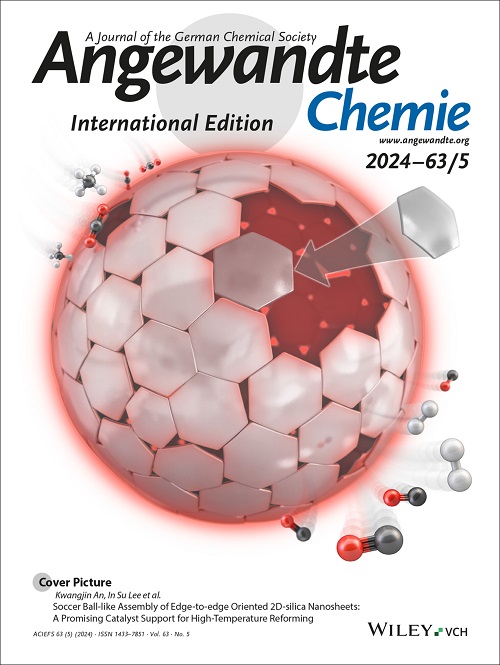Proton-Conducting, Vacancy-Rich HxIrOy Nanosheets for the Fabrication of Low-Ionomer-Dependent Anode Catalyst Layer in PEM Water Electrolyzer
IF 16.1
1区 化学
Q1 CHEMISTRY, MULTIDISCIPLINARY
引用次数: 0
Abstract
The anode catalyst layer is composed of catalytically functional IrOx and protonic conducting ionomer, and largely dictates catalytic performance of proton exchange membrane water electrolyzer (PEMWE). Here, we report a new type of anode nanocatalysts that possesses both IrOx’s catalytic function and high proton conductivity that traditional anode catalysts lack, and demonstrate its ability to construct high-performance, low-ionomer-dependent anode catalyst layer, the interior of which—about 85% of total catalyst layer—is free of ionomers. The proton-conducting anode nanocatalyst is prepared via protonation of layered iridate K0.5(Na0.2Ir0.8)O2 and then exfoliation to produce cation vacancies-rich, 1 nm-thick iridium oxide nanosheets (labeled as □-HxIrOy). Besides being a proton conductor, the □-HxIrOy is found to have abundant catalytic active sites for the oxygen evolution reaction due to the optimization of both edge and in-plane iridium sites by multiple cation vacancies. The dual functionality of □-HxIrOy allows the fabrication of low-iridium-loading, low-ionomer-dependent anode catalyst layer with enhanced exposure of catalytic sites and reduced electronic contact resistance, in contrast to common fully mixed catalyst/ionomer layer in PEMWE. This work represents an example of realizing the structural innovation in anode catalyst layer through the bifunctionality of anode catalyst.质子导电、富空位的HxIrOy纳米片在PEM水电解槽中制造低离聚体依赖阳极催化剂层
阳极催化剂层由具有催化功能的IrOx和质子导电离聚体组成,在很大程度上决定了质子交换膜水电解槽(PEMWE)的催化性能。在这里,我们报道了一种新型阳极纳米催化剂,它既具有IrOx的催化功能,又具有传统阳极催化剂所缺乏的高质子导电性,并证明了它能够构建高性能、低离聚体依赖的阳极催化剂层,其内部(约占总催化剂层的85%)不含离聚体。通过层状铱酸盐K0.5(Na0.2Ir0.8)O2的质子化,然后剥离得到富含阳离子空位的1 nm厚的氧化铱纳米片(标记为□-HxIrOy),制备了质子导电阳极纳米催化剂。除了作为质子导体外,□-HxIrOy还具有丰富的析氧反应催化活性位点,这是由于多个阳离子空位对边缘和平面内铱位点进行了优化。□-HxIrOy的双重功能允许制造低铱负载,低离子依赖的阳极催化剂层,与PEMWE中常见的完全混合的催化剂/离子层相比,具有增强的催化位点暴露和降低的电子接触电阻。本研究是利用阳极催化剂的双功能实现阳极催化剂层结构创新的一个实例。
本文章由计算机程序翻译,如有差异,请以英文原文为准。
求助全文
约1分钟内获得全文
求助全文
来源期刊
CiteScore
26.60
自引率
6.60%
发文量
3549
审稿时长
1.5 months
期刊介绍:
Angewandte Chemie, a journal of the German Chemical Society (GDCh), maintains a leading position among scholarly journals in general chemistry with an impressive Impact Factor of 16.6 (2022 Journal Citation Reports, Clarivate, 2023). Published weekly in a reader-friendly format, it features new articles almost every day. Established in 1887, Angewandte Chemie is a prominent chemistry journal, offering a dynamic blend of Review-type articles, Highlights, Communications, and Research Articles on a weekly basis, making it unique in the field.

 求助内容:
求助内容: 应助结果提醒方式:
应助结果提醒方式:


